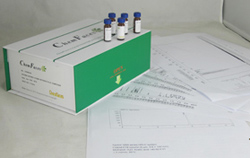Hot Products



| Catalog No. | Information |
| CFN96831 | Lupeol palmitate Lupeol palmitate is a natural product from Ligularia songarica. |
| CFN96255 | Lupeolic acid Lupeolic acid has anti-inflammatory activity. |
| CFN80045 | Lupinalbin A Lupinalbin A as the most potent estrogen receptor α- and aryl hydrocarbon receptor agonist in Eriosema laurentii de Wild. (Leguminosae). It exerts anti-inflammatory effects via the inhibition of pro-inflammatory cytokines and blocking of IFN-β/STAT1 pathway activation. |
| CFN00510 | Lupinine |
| CFN96146 | Lupiwighteone Lupiwighteone has anti-angiogenesis potential, it also has anticancer and cancer preventive effects on SH-SY5Y cells. |
| CFN92784 | Lusianthridin Lusianthridin shows appreciable cytotoxicity against human lung cancer cell lines. It exhibits anti-migratory property at nontoxic concentrations. |
| CFN99384 | Lutein Lutein and lycopene has chemopreventive activity, the possible mechanism is their antioxidant effects. Nutritional supplementation with lutein or lutein together with antioxidants, vitamins, and minerals, improves visual function and symptoms in atrophic age-related macular degeneration (ARMD). |
| CFN98784 | Luteolin Luteolin is a non-selective phisphodiesterase PDE inhibitor for PDE1-5 with Ki of 15.0 μM, 6.4 μM, 13.9 μM, 11.1 μM and 9.5 μM, respectively. Luteolin has anti-oxidant, anti-inflammation, anti-allergy anti-myocardial ischemia-reperfusion injury, and anticancer, has been used in Chinese traditional medicine for treating various diseases such as hypertension, inflammatory disorders, and cancer. Luteolin inhibits NF-κB, and inhibits interleukin (IL)-1β function induction of the inflammation biomarker cyclooxygenase (COX)-2. |
| CFN98573 | Luteolin 7,3'-di-O-glucuronide Reference standards. |
| CFN70468 | Luteolin 7-diglucuronide Luteolin-7-diglucuronide( L7DG) is pharmacologically effective in protecting the heart against developing ISO-induced injury and fibrosis, justifying further evaluation of L7DG as a cardioprotective agent to treat related cardiovascular diseases. |